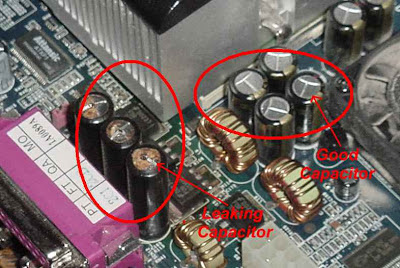How to Troubleshoot a Bad Motherboard and Its Components
Motherboard is the main part of a computer system. As its name suggest, it serves to connect all parts of a computer together. The CPU, HDD's (Hard Disk Drives), Optical Drives, Power Supply, Video Cards, Sound Cards & Peripheral Components like Keyboards, Mouse, Monitor, Speakers etc. are all connected to the motherboard via cables or directly. In short, it is the "Back Bone" of a computer system.
Sometimes, due to over working, static discharge or electricity failure, it might stop working. In this case, you have to diagnose the faulty components of the motherboard. Follow these steps to identify these:
Check for the Bad Capacitors
In 70% cases, these are the bad capacitors which are the victim for a motherboard to stop working. So first of all, check its capacitors. It is easy to identify the bad capacitors, these are the ones with the bulging top and leaking electrolytic goo.
To replace them, you will need:
- Soldering Iron
- New capacitors of the same capacity as the old ones
- Experience in soldering and knowledge of the risk involved
Always be careful to replace them, because one false move will completely make your board dead.
Troubleshoot the Power Supply Unit
If capacitors are fine then it might be the Power Supply Unit (PSU) causing the problem. First of all, check the power cables & supply, if there is a damage cable then replace it with a new one. If your supply is good and power cable is checked and working fine then the problem is with your PSU, so replace it.
Replacing a dead PSU is very easy. All you have to do is to buy a new one with the same size & dimensions as your old one. To replace, open your System Unit, unplug the cables & replace the old with the new one.
Video Adapter
If the computer turns "on" then press the "Num Lock" key, if the light turns "on" but you don't see anything on the monitor then it'll be your video card which is busted.
The solution is that you take the card out of the unit & look for dust in its heat-sink & fan, if there is any then clean it out. Also look at its motherboard connector, if there are any carbon particles then remove them using cotton or rubber. Also check that if fan is working or not, if not then card might be dead due to over-heating, in this case you have to replace the card.
RAM & CPU (Processor)
Your usual signs of RAM failure include the BSoD (Blue Screen of Death), low computing speeds and slow booting. The first step is to check whether the RAM is inserted in the given slot properly. Improper insertion of the RAM modules must be checked. If the RAM is positioned properly and even then your computer is not working, change the RAM. RAMs are also quite prone to damage due to power surges and static discharge. Replacing it is relatively cheaper and easier, so this won't prove too bad if it happens.
If the RAM is positioned and working properly, check whether the CPU (Processor) is inserted in its socket perfectly or not. This case is possible when you have upgraded your CPU. The heat sink module inside the cabinet is mounted upon the CPU, so it is quite possible that one of the leads of the CPU are bent due to the weight of the heat sink. Check whether the CPU leads are properly inserted in their respective sockets. If you cannot insert the leads properly in the socket, it is likely that the socket is faulty or the CPU that you have is not the correct one for your computer motherboard.
Note: Always remember to keep a backup your important data before handling computer component. Also never try to fix those components which you think are broken. I hope that this article will help you to solve basic hardware problems.
Note: Always remember to keep a backup your important data before handling computer component. Also never try to fix those components which you think are broken. I hope that this article will help you to solve basic hardware problems.


.jpg)
.jpg)
I admire the valuable information you make available in your expertly written content.
ReplyDeleteGreat to know about it, i feels good when you fix the computer issues by yourself instead of paying a amount for small errors. I think all should get training of fixing small errors which can save time and money as well.
ReplyDelete